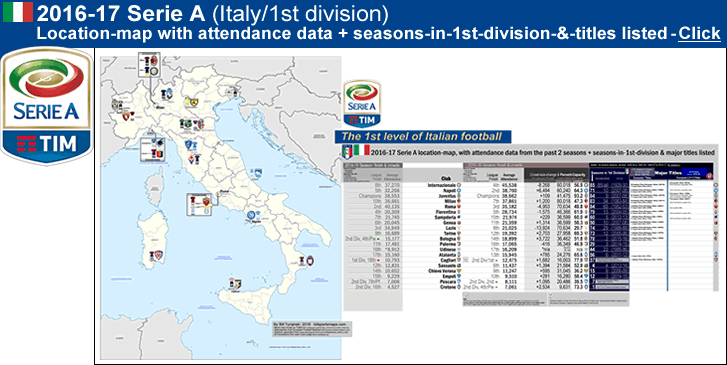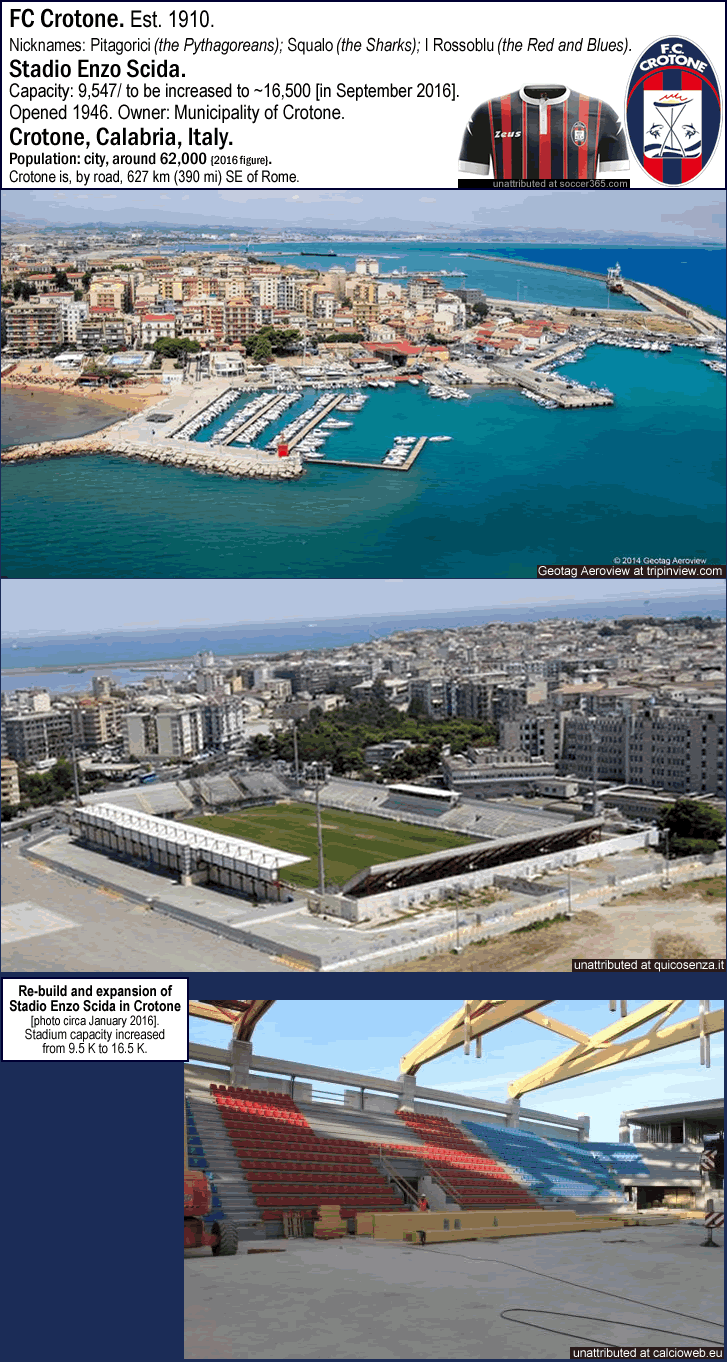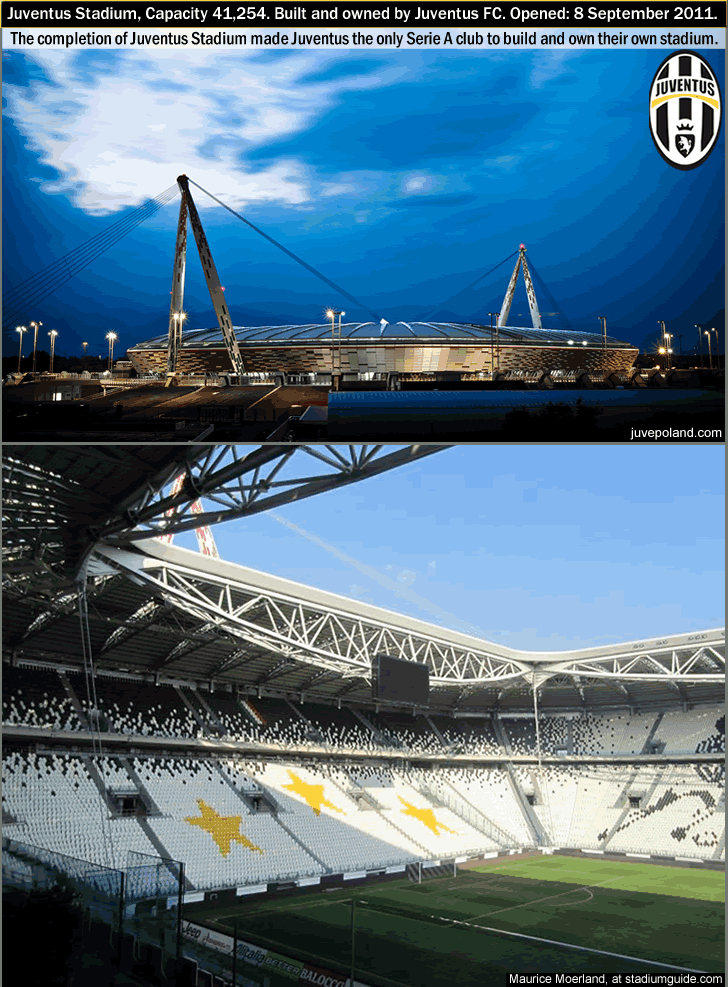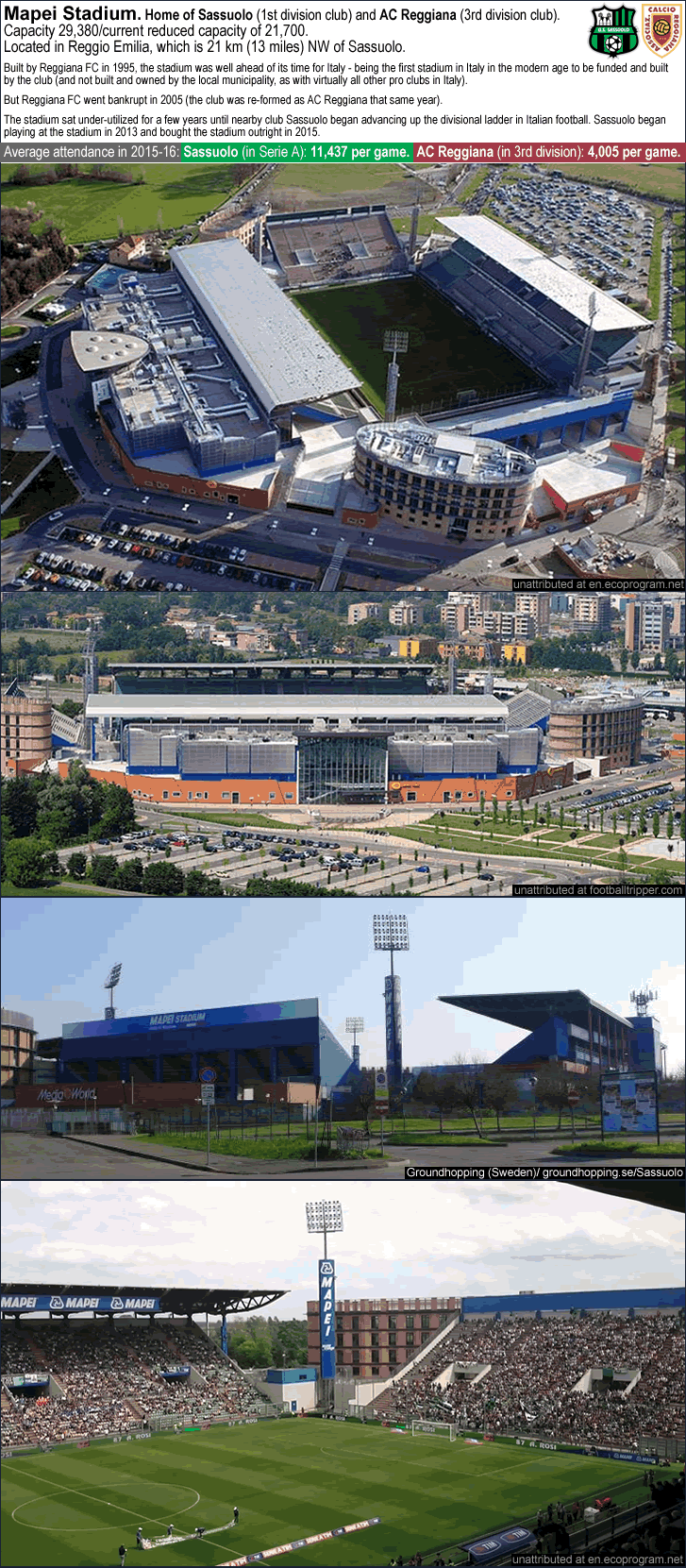
2016-17 Serie A (Italy/1st division) location-map, with: 14/15 attendance data, seasons-in-1st-division-by-club & major titles listed
…
…
By Bill Turianski on 19 September 2016; twitter.com/billsportsmaps.
Links
-Teams, etc…2016-17 Serie A (en.wikipedia.org).
-Table, fixtures, results, stats, etc…Serie A/summary (soccerway.com).
-English-speaking coverage of Italian football…Forza Italian football.com.
-Here is the archive-page of Serie A-focused Guardian.com/football writer Paolo Bandini, {archive page, Paolo Bandini (theguardian.com/profile/paolobandini).}
-16/17 Serie A jerseys…2016/17 SERIE A HOME SOCCER JERSEYS (soccer365.com).
From Forza Italian Football site, here is the Season Preview: Serie A 2016-17 (by Kevin Pogorzelski at forzaitalianfootball.com).
…
-
The 3 promoted clubs in the 2016-17 Serie A (Cagliari, Crotone, Pescara)…
Cagliari won the 2015-16 Serie B. Crotone finished in 2nd place in the 15/16 Serie B. Pescara won the 15/16 Serie B play-offs.
-
• Cagliari
Manager: Massimo Rastelli (age 47, born in Torre de Greico [12 mi SE of Naples]).
(Note: Cagliari is pronounced kaay AA ree [the G and the L are silent]; see/hear this.)
Cagliari Calcio are from the island of Sardinia (which is in the middle of the Mediterranean Sea, about 240 miles off the Italian mainland). Cagliari, who play in a 16-K-capacity stadium (Stadio Sant’Elia), are the only club from Sardinia to have played in the Italian 1st division. The club is located in Cagliari (the largest city of Sardinia), which is on the southern coast of the island. Cagliari has a city population of around 154,000, and a metro-area population of around 451,000 {2015 figures}. The city of Cagliari is, by air, 413 km (257 mi) SW of Rome.
Cagliari won the 2015-16 Serie B by a point (and finished in the automatic places by a solid ten points over the 3rd place finishers). So Cagliari returns in strong form straight back up to the 1st division. Here is an article on the 16/17 Cagliari squad, Reasons To Believe Cagliari Can Defend Their Serie A Status (by Louis Gibberd-Thomas at forzaitalianfootball.com).
Counting the 2016-17 season, Cagliari have played 37 seasons in the Italian 1st division, which is the 13th-most, by club, in Italy. {See this, Serie A/Seasons in Serie A.} Cagliari’s previous stint in Serie A was for 11 seasons (from 2004-05 to 2014-15). The Rossoblu (the Red-Blue), as Calgiari are sometimes known, have been in existence since 1920.
Cagliari: the improbable title-winners of 1969-70…
Cagliari were historically a third-division club – or at best a second-division club…until the mid-1960s. Cagliari first won promotion to Serie A in June 1964. Then, 6 seasons later, led by goal-scoring powerhouse Luigi Riva, the side from the isolated island of Sardinia won the 1969-70 Italian title, in a very convincing fashion.
Luigi Riva was born in Leggiuno (near Lake Maggiore) in north-west Lombardy, near the Swiss border. In 1962 Riva got his start with nearby 3rd-division club Legnano. In the following season of 1963-64, Riva was signed by then-second-division Cagliari, and he was converted from a winger to a striker. Riva ended up playing 9 seasons for Cagliari, scoring 164 goals in 315 league appearances (1963 to 1976). (Riva was sold to Juventus in 1973, but had such loyalty to Cagliari that he famously refused to board the airplane for Turin, and the deal was nullified.) Riva was a natural left-footer and was very effective in the air {check out this brilliant horizontal header Riva scored for Italy versus East Germany in 1969, here}. (Luigi Riva ended up with some pretty impressive international stats…he scored 35 goals in 45 appearances for Italy.) Owing to his powerfully struck shots, Riva was nicknamed the Thunder-Clap (Rombo di Tuono). In 1969-70, Riva scored a league-best 21 goals in 30 games in Cagliari’s title-winning season (back then, Serie A had 16 teams in it).
The year before (1967-68), the Serie A title was a three-horse-race between Milan, Fiorentina, and Cagliari, with Cagliari losing out to Fiorentina by 4 points. In 1969-70, the title-race developed into three-way fight between Juventus, Internazionale, and Cagliari. Cagliari’s manager was the wily Manilo Scopigno, who was a native of far-north-eastern Italy in Friuli. Scopigno had Cagliari play in a variation of the newfangled Dutch total football, with a then-novel use of the sweeper position (the libero) in front of the defensive line (that role was performed by Pierluigi Cera; see photo below). Cagliari’s defense was led by starting Italy goalkeeper Enrico “Ricky” Albertosi, who had been lured over from Fiorentina in 1968. With Albertosi, the Cagliari defense was so impregnable that they only let in 11 goals in 30 games in 1969-70. That made for an astounding average of just 0.36 goals allowed per game, an all-time Italian 1st division record. Another key player for Cagliari was the Brazilian defensive midfielder Nene, who had played with Pele at Santos, and then came over to Italy first with Juventus, and then with Cagliari. Nene played for over a decade for Cagliari (1964-76) (you can see Nene below in the squad-photo, below, at the far upper-left). With the addition of right-winger/playmaker Albero Domenghini (who also can be seen in a photo below), it all came together for Cagliari in 1969-70. By March of 1970, Cagliari began to pull away from the pack, and in the end, the Rossoblu managed to clinch the title with two games to spare, on 12 April 1970 with a 2-0 win over Bari. Below you can see photos from that game. Then the inhabitants of the island of Sardinia celebrated and partied on, for days. Cagliari finished four points ahead of Inter and 7 ahead of Juventus.
The late 1960s was a time when many Sardinians did not have televisions or even radios. Many Sardinians in fact did purchase their first transistor radios in order to follow Cagliari’s title-run that season. It is said that Sardinia first united as an island and truly joined the modern age – and truly joined Italy, for that matter – when Cagliari won the Scudetto in 1970. Here is a great article on Cagliari’s amazing title-winning season, Cagliari 1969-70 (by Jon Spurling, from August 2007, at wsc.co.uk). {Here is a highly recommended book about Italian football which touches on the Cagliari title-win, Calcio: A History of Italian Football, by John Foot (amazon.com).}
Below: 1969-70 Cagliari – the improbable champions of Italy…

Photo and Image credits above –
Photo of 69/70 Cagliari home jersey, photo by retrofootballclub.com/cagliari-1969-70. Photo of Luigi Riva and coach Manlio Scopigno at Cagliari training pitch (circa 1968), photo’s author is unknown, posted at File:Cagliari – Gigi Riva e Manlio Scopigno.jpg (it.wikipedia.org). Photo of GK Enrico “Ricky” Albertosi, photo (circa 1969) unattibuted at magliarossonera.it/Albertosi. Photo of Pierluigi Cera, photo unattributed at repubblica.it. Photo of Angelo Domenghini, photo unattributed at sport.sky.it. Photo of Luigi “Sound of Thunder” Riva, photo’s author is unknown, posted at File:Serie A 1969-70 – Cagliari vs Bari – Pasquale Loseto e Gigi Riva.jpg (it.wikipedia.org). Black-and-white photo of Riva climbing riot fence and saluting Cagliari fans, photo unattributed at s-media-cache-ak0.pinimg.com. Color photo of Riva climbing riot fence and saluting Cagliari fans (as Carabineiri laugh), photo unattributed at s-media-cache-ak0.pinimg.com. Close-up shot of Riva saluting Cagliari fans, photo unattributed at gazzettaworld.com. Photo of Cagliari 1969-70 squad (taken before a game at San Siro in Milan), photo unattributed at gazzettaworld.com/leicesters-success-cagliari-memory.
Below: Cagliari Calcio, Stadio Sat’Elia (opened 1970)…

Photo and Image credits above –
Photo of Cagliari 16/17 jersey, photo unattributed at 2.bp.blogspot.com. Photo of Cagliari, by azamaraclubcruises.com/cagliari-sardinia-italy-cruises. c
Aerial shot of Stadio Sant’Elia, photo unattributed at sardiniapost.it. c. Interior wide-angle sot of stadium, photo by Ansgar Speitz at soccerway.com/teams/italy/cagliari-calcio. Interior shot of main stand, photo by Gigidelneri at File:Trib centrale sant elia.jpg (commons.wikimedia.org). Cagliari supporters at Stadio Sant’Elia, photo by Enrico Nocci at afr-photos.com.
…
• Crotone
Manager: Davide Nicola (age 43, born in Luserna San Giovanni [45 kn (21 mi) SW of Turin), Piedmont). Nicola replaces Croatian ex-Genoa and ex-Crotone player Ivan Jurić, who had gotten Crotone promoted in May 2016 (Jurić is now manager of Genoa).
Here is a preview of the 2016-17 FC Crotone, Crotone ultimate underdogs (by Colin Millar at football-italia.net).
FC Crotone have never been in the top flight previous to 2016-17. The club is from Calabria, near the toe of the boot in the far south of the Italian Peninsula. They have a rather small stadium (former capacity, 9.5 K), which is being expanded to 16.5 K. It is called Stadio Enzo Scida. FC Crotone wear Bologna-style kits (red-and-dark-blue vertically striped jerseys). {Here is an interesting article on Crotone from 1 June 2016, An Underdog's Triumph: Fabulous FC Crotone's promotion highlights Italy's north-south divide (by Franco Ficetola at just-football.com).)
The small city of Crotone has a population of around 62,000 {2016 figure}. Two thousand seven hundred years ago, in 710 BC, as part of Magna Graecia, Crotone was settled, as Croton, by the Peloponnese Greeks (in pre-Roman times). And so one of the nicknames of FC Crotone is Pitagorici (the Pythagoreans), a reference to the great philosopher-and-mathematician Pythagorus, who founded his school (the Pythagoreans), in Croton circa 530 BC. Another nickname of FC Crotone is Squali (the Sharks), and on FC Crotone's crest you can see two sharks swimming around a giant flaming torch (which is physically impossible but makes for a nice image) {crest of FC Crotone}. Crotone are also known as the Rosso-blu.
The deck is seriously stacked against a small club like Crotone surviving in Serie A, and I hope Crotone don't go straight back down - like two other recently-promoted clubs. That would be Frosinone and Carpi, both of whom made their Serie A debuts in 2015-16, and both of whom went straight back down to the 2nd division ten months later.
It certainly is not helping that Crotone have had to play their first 3 home matches 279 miles away - in Pescara - because their stadium expansion has not been finished in time. Crotone have drawn less than one thousand for these games, and in their latest loss, 1-3 to Atalanta on 23 September, there were just 521 in attendance.

Photo and Image credits above -
Photo of 16/17 FC Crotone jersey unattributed at 2016/17 SERIE A HOME SOCCER JERSEYS (soccer365.com). Aerial photo of Crotone, photo by Geotag Aeroview at tripinview.com. Exterior view of Stadio Enzo Scida, photo unattributed at quicosenza.it/sport/crotone-calcio-oliverio-festeggia-la-serie-a-regalando-un-nuovo-stadio. Photo of the re-build, showing the installation of one of the new stands at Crotone, photo unattributed at calcioweb.eu.
...
• Pescara
Manager: Massimo Oddo (age 40, born in Città Sant'Angelo, 14 km (9 mi) NW of Pescara). Oddo was a right-back with a long first-division career at Verona, Lazio, Milan, and Bayern Munich. Oddo retired from the pitch in 2012 with Lecce, then went into coaching as Genoa youth team coach. He was hired as an assistant coach at his home-town Pescara in 2014, and stepped in as caretaker in May 2015, when Pescara had failed to make the 14/15 Serie B play-offs. The following season (2015-16), Oddo got Pescara promoted back to Serie A with a 3-1 aggregate win over Trapani in the 15/16 Serie B play-off Finals. {See this, Pescara promoted to Serie A after beating Trapani in playoff final (espnfc.com).}
Delfino Pescara 1936 wear sky-blue-and-white vertically-striped jerseys, and as their moniker suggests, are nicknamed Delfini (the Dolphins). Counting 2016-17, Pescara have spent 7 seasons in Serie A; their previous spell was for a single season in 2012-13. Their Stadio Adriatico, which has a 20.5 K-capacity, unfortunately has an atmosphere-destroyng running track.
Here is a preview of the 2016-17 Pescara...Sink or swim for Delfini (by Rossella Marrai-Ricco at football-italia.net).
Pescara is on the Adriadtic Sea in the region of Abruzzo. Pescara has a city-population of around 123,000 and a metro-population of around 450,000 {2009 figures}. Pescara has 30 kilometres of beaches, and is a tourist destination. The coastal part of Abruzzo is sort of similar to Los Angeles/southern California - not for the lifestyle, but for the fact that much like in LA, in Abruzzo you could lay on the beach in the morning and in the afternoon you could be skiing the nearby slopes. Except in Abruzzo, the distance from the beautiful beaches to the snowy high mountains is only a distance of about 32 km (20 mi). As it says in Pescara's wikipedia page, "The city is very close to the mountains, and you can reach the ski slopes of Passo Lanciano in just 30 minutes." (See photo below, which shows Pescara's marina with the one-and-a-half-mile-high peaks of the Central Apennines in the distance.)

Photo and Image credits above -
Photo of Pescara 16/17 jersey, photo unattributed at soccerstyle24.it/pescara-home-16-17.jpg Photo of dwellings in old town in Pescara, photo unattributed at italiancook.ca/Abruzzo. Photo of beach at Pescara, photo by Luca Aless at File:Pescara - Spiaggia vista dal ponte del mare.JPG. Photo of marina at Pescara with snow-covered mountains in the background, photo unattributed at madeinsouthitalytoday.com. Photo of Pescara with stadium in background, photo unattributed at kukly-bratc.ru/[Pescara]. Aerial shot of Stadio Adriatico, photo unattributed at calcioefinanza.it/2015/11/09/stadio-pescara-nuovo-impianto-entro-la-stagione-2018-2019.
…
Extra feature…
The ongoing upgrades in Italian first division stadiums…
First it was Juventus who lead the way to a re-think in Italian stadium design, with their magnificent Juventus Stadium (which opened in 2011). Not only does Juventus Stadium have all the modern conveniences, but it also features steep-graded stands for better sight-lines and no accursed running track. And unlike every other top flight stadium at the time, Juventus Stadium is owned by the club (and not the municipality). Like in England and Germany and Spain and France (among other places).

Photo and Image credits above -
juvepoland.com.
Interior photo of Juventus Stadium by Maurice Moerland, at stadiumguide.com/juventusstadium.
Then clubs like Roma and Sampdoria made plans of their own for self-funded new stadiums. {See this, Roma stadium three years away (football-italia.net). See this, Sampdoria Present New Stadium Plans (viva-news.com).} Milan and Fiorentina also have ambitions to build and own their own stadiums {see this, 7 Stadiums Which Could Rejuvenate Serie A (football-tripper.com from July 2015)}. And up in Friuli in north-east Italy, Udinese got the municiplity of Udine to work with them to totally re-design the Stadio Friuli, which you can see further below. Hopefully the trend for new and better stadiums in Serie A will bear more fruit. It also must be pointed out that Sassuolo now own their own stadium – Mapei Stadium-Città del Tricolore, and you can see that stadium below.
Below, Mapei Stadium (opened 1995) – owned by first division club US Sassuolo…
Mapei Stadium. Home of Sassuolo (1st division club) and AC Reggiana (3rd division club).
Capacity 29,380/current reduced capacity of 21,700. Located in Reggio Emilia, which is 21 km (13 miles) NW of Sassuolo. Built by Reggiana FC in 1995, the stadium was well ahead of its time for Italy – being the first stadium in Italy in the modern age to be funded and built by the club (and not built and owned by the local municipality, as with virtually all other pro clubs in Italy). But Reggiana FC went bankrupt in 2005 (the club was re-formed as AC Reggiana that same year). The stadium sat under-utilized for a few years until nearby club Sassuolo began advancing up the divisional ladder in Italian football. Sassuolo began playing at the stadium in 2013 and bought the stadium outright in 2015.

Photo and Image credits above –
Aerial shot of stadium, photo unattributed at en.ecoprogram.net. Exterior shot of stadium, photo unattributed at footballtripper.com/jpg. Exterior shot of stadium (street-level/side-view), photo by Groundhopping (Sweden) site groundhopping.se/Sassuolo. Interior shot of stadium (during pre-match), photo unattributed at en.ecoprogram.net.
Udinese: the massive re-build at Stadio Friuli in Udine, Friuli-Venezia Guilia…
The stadium originally had poor sight-lines due to the vast gap created by the running track, as well as the shallow incline of the seating in the bowl of the stands. So, everything except the Main Stand’s arced roof was torn out. Emulating Juventus’ recently-built stadium, the new stands at Stadio Friuli were built at a much steeper angle, for better sight-lines. A roof over all the re-built parts completes the stunning new look of Stadio Friuli (now officially called the Dacia Arena).

Photo and Image credits above -
Stadium before renovation, photo unattributed at skyscrapercity.com. Aerial shot of re-built Stadio Friuli, photo by Elio Meroi at sporteconomy.it. Interior photo of Stadio Friuli (aka Daci Arena), photo by Matteo.favi at File:DaciArena.jpg (commons.wikimedia.org). Opening match at re-built Stadio Friuli, photo unattributed at voazzurro.it.
___
Thanks to all at the links below…
-Blank map of Italy by TUBS, at File:Italy provincial location map.svg.
-Attendances from E-F-S site, european-football-statistics.co.uk/attn.htm.
-2015-16 stadium capacities (for league matches) from osservatoriosport.interno.gov.it/allegati/stadi_italiani_3.pdf.
-General info, crests, kit illustrations, from 2016-17 Serie A (en.wikipedia.org).
